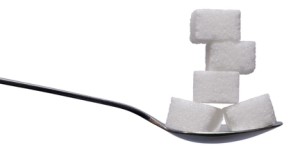Gerber claims their iron-fortified rice cereal is just what babies need when they’re ready to start eating solid foods.
But according to Gerber’s ingredients, the product is neither good nor safe.
“The iron in Gerber Cereal means you’re literally giving him food for thought.”
I was scrolling through People magazine, waiting in line at my local grocery store, when I came across these words splattered across the image of a tousled-hair, bright-eyed cherub who looked much like the original Gerber sketch of 1928.
I wondered if this was all smoke and mirrors and, upon doing some research, found five reasons why this baby food should be classified as “crap.”

1. Spoonfuls of Sugar
The number one ingredient in Gerber Rice Cereal is white rice flour, which means you’re basically feeding your child a whole bunch of starch. Not only is this ingredient processed, but it’s also high in calories and devoid of real nutrients.
Giving your child Gerber “is basically like giving your child a spoonful of sugar,” says Dr. Alan Greene, a pediatrician from Stanford University.
According to him, feeding a baby bleached white rice can also predispose a child to obesity. If you think about it, feeding your child Gerber Rice Cereal creates a negative taste imprint that can cause bad food choices later in life.
2. Not By A Long Chalk
These days, calcium is added to all kinds of foods, from orange juice to Spaghetti-Os. When a food manufacturer wants to ensure a baked good will rise, they might add calcium carbonate because it acts as both a leavening agent and a (substandard) calcium source.
Incidentally, calcium carbonate is also used as a building material because it’s basically limestone. Yummy!
The primary justification for ingesting calcium carbonate is to “support bones.” Lancet and the British Medical Journal, however, published the results of two extensive clinical trials that concluded calcium plus vitamin D do nothing to prevent bone loss.
Meanwhile, it takes our bodies 12 steps to convert calcium carbonate into calcium bicarbonate, which is the form of calcium we can absorb. So why do they use it? It’s chalk—it’s relatively cheap to produce.
Want to give your baby calcium? Give him or her real food in the form of collard greens, spinach, broccoli, okra or prunes. Leave the chalk for the classroom and construction.
3. Arsenic
In November 2012, Consumer Reports magazine published “Arsenic in Your Food,” a report on arsenic in rice. They revealed that some infant rice cereals contain five times as much inorganic arsenic as alternatives like oatmeal—and calculated that a baby “who eats two to three servings of rice cereal a day could end up with a risk of cancer that’s twice what CR considers an acceptable level.”
Yes, it’s true that doctors have touted rice as a ‘first food,’ but the perspective is changing. Rice is bland, and experts now say giving your baby more flavorful foods from the get-go can discourage picky eating later. So, from a nutritional perspective, there’s no reason to feed rice cereal to your baby.
4. Soy Lecithin
Why has soy lecithin also found its way into so many processed foods? According to its label, Gerber adds less than two percent. But why? For starters, it emulsifies, reduces stickiness and extends shelf life. But how does that benefit your baby?
The answer is it doesn’t. Soybeans are considered a “major food allergen” by the Food and Drug Administration. Which parent wants to feed that to their child, regardless of the amount? Furthermore, 96 percent of soybeans in this country are now genetically engineered, which means your child is eating frankenfood even before she has teeth.
5. Faux Iron
“Baby’s No. 1 food source for Iron” (for those starting on solid foods); “available in an easy-to-use package”. This is Gerber’s claim, but I would say it’s a flat-out lie.
“Electrotrolytic” iron is listed as the sixth ingredient on the label. So there isn’t much of it.
Meanwhile, a baby can only absorb a mere four percent of this fortified powdered stuff compared to 50 percent of iron in breast milk. To add insult to injury, this form of iron is artificial and is the least absorbable type. But it makes its way into :an easy to use package” of cereal because it’s cheaper and extends shelf life.
Want to feed your child iron? There are several better options, including organic meats, beans and spinach.
Adapted from HoneyColony article “5 Reasons to Keep Gerber Away From Your Baby” by Maryam Henein. Published with permission.
 Maryam Henein–a native Montrealer—is an investigative journalist, professional researcher, and producer of the award-winning documentary Vanishing of the Bees. She is also the Founder & CEO of HoneyColony.com.
Maryam Henein–a native Montrealer—is an investigative journalist, professional researcher, and producer of the award-winning documentary Vanishing of the Bees. She is also the Founder & CEO of HoneyColony.com.
Her immersion in nutrition science and alternative healing started about 10 years ago, on the heels of a near death experience. This brush with death also raised Maryam’s awareness of the environment, which inspired her to work on a piece on the Exxon Valdez Oil spill for Robert Greenwald and The Sierra Club. Shortly thereafter, the bees flew into Maryam’s life.
Through HoneyColony, Maryam has fused her reporting skills with her love of nutrition and social media in a cooperative model that closely resembles the workings of a real hive. Maryam is dedicated to empowering folks to be their own best health advocate.
Baby images via shutterstock here and here.
Sugar cube image via shutterstock.
